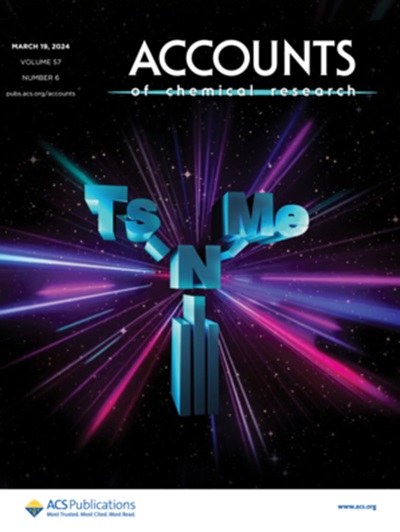Decoding the Penicillin-Binding Proteins with Activity-Based Probes.
IF 16.4
1区 化学
Q1 CHEMISTRY, MULTIDISCIPLINARY
引用次数: 0
Abstract
ConspectusThe bacterial cell wall is a complex structure that is primarily composed of peptidoglycan (PG), which provides protection from the environment and structural rigidity for the cell. As such, PG plays an important role in bacterial survival, which has made its biosynthesis a crucial target for antibiotic development for many decades. Despite long-standing efforts to inhibit PG construction, much remains unknown about the enzymes required for PG biosynthesis or how PG composition and architecture are altered to enable adaptation to environmental stressors. This knowledge will be crucial in the identification of new ways to interfere with PG construction that could overcome widespread resistance to cell wall-targeting antibacterial agents.All bacterial species possess a suite of penicillin-binding proteins (PBPs), which are critical actors in PG construction and remodeling, as well as the main targets of β-lactam antibiotics. While the importance of the PBPs is well-known, the field lacks a complete understanding of PBP activity regulation, localization, and critical protein-protein interactions during the growth and division process. Bacteria possess between 4 and 16 PBP homologues with only one or several being genetically essential in each cell. A key outstanding question about these proteins is why bacteria expend the energy required to maintain this relatively large number of related proteins when so few are required to maintain life. The Carlson lab focuses on the development of chemical tools to address this fundamental question. In particular, we have generated a suite of chemical probes to selectively target one or a small number of PBP homologues in their catalytically active state. These activity-based probes (ABPs) have and will continue to enable a deeper understanding of the traits that differentiate the PBPs over the bacterial lifespan.In this account, we discuss the development of selective chemical tools to study the PBPs. Key to our success has been assessment of the PBP inhibition profiles of an expansive set of commercially available β-lactams in both Gram-positive and Gram-negative bacteria. This work has directly identified molecules that can be used in chemical genetic studies and provided scaffolds for the generation of PBP-selective ABPs. We also discovered a novel β-lactone scaffold that is exquisitely selective for PBPs over other protein classes and targets a different subclass of these proteins than related β-lactams. Using these probes, we have explored PG biosynthesis in Streptococcus pneumoniae, Escherichia coli and Bacillus subtilis yielding new insights about their cell wall construction and remodeling processes, as well as specialized activities under stress.利用活性探针解码青霉素结合蛋白。
细菌细胞壁是一个复杂的结构,主要由肽聚糖(PG)组成,它提供了对环境的保护和细胞的结构刚性。因此,PG在细菌生存中起着重要的作用,这使得它的生物合成成为几十年来抗生素开发的关键目标。尽管长期以来人们一直在努力抑制PG的构建,但对于PG生物合成所需的酶,以及PG的组成和结构是如何改变以适应环境压力的,我们仍然知之甚少。这一知识对于确定干扰PG构建的新方法至关重要,这种方法可以克服对细胞壁靶向抗菌剂的广泛耐药性。所有细菌都具有一套青霉素结合蛋白(PBPs),这是PG构建和重塑的关键参与者,也是β-内酰胺类抗生素的主要靶点。虽然PBP的重要性是众所周知的,但该领域对PBP活性调控、定位以及生长和分裂过程中关键的蛋白质-蛋白质相互作用缺乏完整的了解。细菌拥有4到16个PBP同源物,每个细胞中只有一个或几个是遗传必需的。关于这些蛋白质的一个关键的突出问题是,为什么细菌需要消耗能量来维持相对大量的相关蛋白质,而维持生命所需的能量却如此之少。卡尔森实验室致力于开发化学工具来解决这个基本问题。特别是,我们已经生成了一套化学探针,可以选择性地靶向一个或少数处于催化活性状态的PBP同源物。这些基于活性的探针(ABPs)已经并将继续使人们能够更深入地了解在细菌生命周期中区分PBPs的特征。在本文中,我们讨论了选择性化学工具的发展,以研究PBPs。我们成功的关键是评估了一组广泛的市售β-内酰胺在革兰氏阳性和革兰氏阴性细菌中的PBP抑制谱。这项工作直接鉴定了可用于化学遗传学研究的分子,并为pbp选择性ABPs的产生提供了支架。我们还发现了一种新的β-内酯支架,它对PBPs的选择性优于其他蛋白质类,并且针对的是这些蛋白质的不同亚类,而不是相关的β-内酰胺。利用这些探针,我们探索了PG在肺炎链球菌、大肠杆菌和枯草芽孢杆菌中的生物合成,对它们细胞壁的构建和重塑过程以及应激下的特殊活动有了新的认识。
本文章由计算机程序翻译,如有差异,请以英文原文为准。
求助全文
约1分钟内获得全文
求助全文
来源期刊

Accounts of Chemical Research
化学-化学综合
CiteScore
31.40
自引率
1.10%
发文量
312
审稿时长
2 months
期刊介绍:
Accounts of Chemical Research presents short, concise and critical articles offering easy-to-read overviews of basic research and applications in all areas of chemistry and biochemistry. These short reviews focus on research from the author’s own laboratory and are designed to teach the reader about a research project. In addition, Accounts of Chemical Research publishes commentaries that give an informed opinion on a current research problem. Special Issues online are devoted to a single topic of unusual activity and significance.
Accounts of Chemical Research replaces the traditional article abstract with an article "Conspectus." These entries synopsize the research affording the reader a closer look at the content and significance of an article. Through this provision of a more detailed description of the article contents, the Conspectus enhances the article's discoverability by search engines and the exposure for the research.
 求助内容:
求助内容: 应助结果提醒方式:
应助结果提醒方式:


